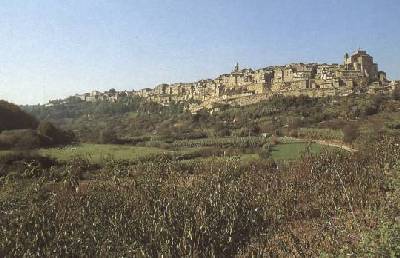Grotte
di Castro is an agricultural town situated to the north of
Lake Bolsena. It has ancient origins dating back to the
Etruscans who left traces of their civilisation everywhere
in the territory. More to the south, Civita proudly
features the remains of an ancient aqueduct, shafts for
collecting water and an ancient route. A number of
necropolis surround the village, the oldest of which dates
back to the half of the 7th century B.C. and it
is characterised by the presence of the so-called
caisson-tombs which are particularly typical of Vigna la
Piazza Necropolis (arguably the oldest of the whole
archaeological complex). Over the last two decades of the
7th century B.C. the first chamber-tombs (a
camera) were found and they can still be admired in the
necropolis of Pianezze.
In Grotte di Castro one can experience the classic
pleasures of a genuine way of living, which have kept
intact throughout the centuries. Its produce include wine,
olive oil and potatoes for which a feast is celebrated in
August, "La sagra della patata".
Between the end of the 4th century and the
beginning of the 3rd, Civita suffered from the
Roman expansionism. However, the town survived, until the
devastating Longobard raids submitted it. That was the
only time the whole town left and moved onto a near tufa
crag, smaller in height but less vulnerable and more
easily defensible. In the beginning, the people had to
live in caves of tufa rock, by which the town was given
the name of Grotte di Castrum Criptarum. |
 |
| The first
settling can be identified with the area where now
stands the majestic Baroque Basilica of Maria SS.
Del Suffragio. This church was built in 1626 on a
pre-existent 8th century structure by
Girolamo Rainaldi and it was completed by Andrea
Selvi. In its inside a precious statue of the
Madonna del Suffragio, made of polychrome wood, is
preserved and venerated by the town that organizes
an important celebration every ten years. In the
Basilica basement there are numerous rooms from the
old Pievana, hosting a museum, which exhibits a good
number of paraments, sacred objects and a collection
of Etruscan finds. |
|
There
is another building dating back to the early Middle Ages:
it is the parish church of San Pietro Apostolo built under
the auspices of Countess Matilde di Canossa and
consecrated in 1118 by Bishop William. What remains of the
old structure is only the Romanesque bell tower, the rest
of the church having been modified over the centuries. The
church preserves 17th century paintings and an
18th century wooden crucifix.
Grotte di Castro had also the good fortune to be part of
The Dukedom of Castro. In those times, the old medieval
centre underwent a significant expansion, as demonstrated
by the construction of e few stately palaces, such as the
Innocenzo Iuzzi and Municipal ones. The latter was erected
by Vignola in the second half of the 16th
century. An attractive stone spiral staircase connects its
numerous floors. Story has it that this staircase was
brought to Grotte after the destruction of the town of
Castro. Another remarkable monument is "La Fontana
Grande" (Grand Fountain) built in 1886 to supply the
population with fresh water. The 18th century
Palazzo del Podestŕ hosts the "Archaeological and
Country Heritage Museum" of Grotte di Castro (Museo
civico e archeologico e delle tradizioni popolari) opened
in 1993. About 160 Etruscan finds dating to the 7th-8th
centuries (Web site: http://www.museionline.com/),
from the necropolis of Vigna la Piazza and Pianezze, are
exhibited here as ulterior signs of the town's noble
history. |


